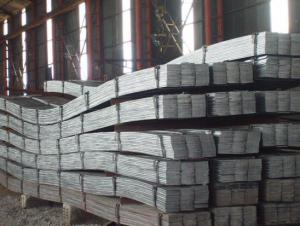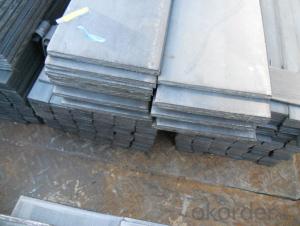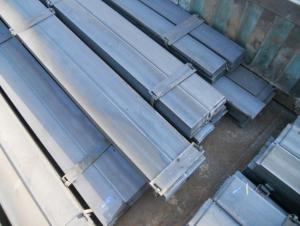FLAT BAR 20-200
- Loading Port:
- China Main Port
- Payment Terms:
- TT OR LC
- Min Order Qty:
- -
- Supply Capability:
- -
OKorder Service Pledge
OKorder Financial Service
You Might Also Like
Product Description:
Product Description:
Specification of Mild Steel Flat Bar
Commodity: Mild Steel Flat Bar
Standard: GB;JIS
Material: Q195-235;SS400
Brand name: FLATSPACE
Origin place: China
Thickness: 3mm-30mm
Width:20mm-200mm
Length: Max 12m
Certification: SGS/BV
Chemical composition of Q235
Alloy No | Grade | Element(%) | ||||
C
| Mn
| S
| P
| Si
| ||
Q235
|
B
|
0.12—0.20 |
0.3—0.7 |
≤0.045 |
≤0.045
|
≤0.3
|
Physical properties of Q235
Alloy No | Grade | Yielding strength point(Mpa) | Tensile strength (Mpa) | Elongation after fracture(%) | ||||||
Thickness (mm) | Thickness (mm) | |||||||||
≤16 | >16--40 | >40--60 | >60--100 |
| ≤16 | >16--40 | >40--60 | >60--100 | ||
≥ | ≥ | |||||||||
Q235 |
B |
235 |
225 |
215 |
205 |
375--500 |
26 |
25 |
24 |
23 |
Usage/Applications of Mild Steel Flat Bar
Widely used for construction, Machinery manufacturing, Iron tower steel structure, Shipbuilding; Steel grating, Staircase, Bridge, Viaduct, Railway spare parts, Boilers making etc.
Packaging & Delivery of Mild Steel Flat Bar
Packaging Details: The Mild Steel Flat Bars are packed in bundles and loaded in 20 feet/40 feet container, or shipped by bulk cargo ,also we can do as customer's requirements.
Delivery Details:30~45 days upon the receipt of buyer payment by T.T. or L/C.
Production Flow of Mild Steel Flat Bar
The Mild steel flat bar is made through three processes:
1.Feeding the material: Feeding the row material (the steel plate) to Slitting Line.
2.Slitting:The steel plate would be slitted into expected width by lengthways cutter.
3. Leveled and cutting: The plat bar would be ground into level by the grinder and then cut into required length
- Q: Can steel flat bars be used in the aerospace industry?
- Yes, steel flat bars can be used in the aerospace industry. They are often utilized for various applications such as structural components, brackets, and support systems due to their strength, durability, and versatility. However, they must meet stringent quality and performance standards to ensure safety and reliability in the demanding aerospace sector.
- Q: What is the cost of steel flat bars compared to other materials?
- The cost of steel flat bars compared to other materials can vary depending on several factors. Steel is generally considered to be a cost-effective material due to its abundance and versatility. It is widely available and produced at a large scale, which helps keep the cost relatively low compared to other materials. In comparison to materials like aluminum or titanium, steel flat bars are generally more affordable. Aluminum is lighter and has a higher strength-to-weight ratio, but it is also more expensive due to the higher cost of production and raw materials. Titanium, on the other hand, is known for its exceptional strength and corrosion resistance, but it is significantly more expensive than steel. However, it is important to note that the cost of steel flat bars can also vary based on the specific type and grade of steel used. Different grades of steel, such as carbon steel or stainless steel, can have different price points based on their properties and applications. Additionally, market factors such as supply and demand, production costs, and location can also influence the cost of steel flat bars. Overall, while steel flat bars are generally considered to be a cost-effective option compared to other materials, it is necessary to consider the specific requirements and properties needed for a particular application to accurately assess the cost.
- Q: Can steel flat bars be welded?
- Yes, steel flat bars can be welded. Welding is a common and widely used method for joining or repairing steel materials, including flat bars. The process involves heating the steel to its melting point and then fusing the two pieces together using a welding electrode or filler material. The resulting weld creates a strong and durable bond, making it suitable for various applications in construction, manufacturing, and other industries where steel flat bars are commonly used. However, it is important to follow proper welding procedures and techniques to ensure a successful and structurally sound weld.
- Q: How do steel flat bars perform in high-pressure environments?
- Steel flat bars perform well in high-pressure environments due to their high tensile strength and resistance to deformation. They can withstand the pressure and distribute it evenly, making them suitable for applications such as hydraulic systems, pressure vessels, and pipelines.
- Q: How do steel flat bars contribute to the fire resistance of structures?
- Steel flat bars contribute to the fire resistance of structures in several ways. Firstly, steel is a non-combustible material, which means it does not burn or contribute to the spread of fire. This property alone makes steel flat bars an excellent choice for construction in fire-prone areas. Additionally, steel flat bars have a high melting point compared to other materials commonly used in construction. This means that in the event of a fire, steel flat bars will maintain their structural integrity for a longer period of time, providing a secure framework for the building. This is crucial for the safety of occupants and firefighters, as it allows for a longer period of evacuation and firefighting efforts. Furthermore, steel flat bars can act as fire barriers, preventing the spread of flames from one area of the structure to another. When used in conjunction with fire-resistant materials such as gypsum board or concrete, steel flat bars can create compartmentalized spaces that contain the fire, limiting its ability to spread and minimizing the damage caused. Moreover, steel flat bars can help to reinforce the overall strength and stability of a structure, even under extreme heat conditions. This is due to the high tensile strength and durability of steel. By incorporating steel flat bars into the structural design, buildings can be better equipped to withstand the effects of fire and maintain their load-bearing capacity. In summary, steel flat bars contribute to the fire resistance of structures by being non-combustible, maintaining their structural integrity at high temperatures, acting as fire barriers, and enhancing overall structural strength. These properties make steel flat bars an essential component in fire-resistant construction, ensuring the safety and longevity of buildings in the face of fire hazards.
- Q: Can steel flat bars be used for making conveyor belts?
- No, steel flat bars are not suitable for making conveyor belts. Conveyor belts require flexible and durable materials that can bend and conform to the shape of the pulleys and rollers while maintaining strength and durability. Steel flat bars are rigid and inflexible, making them unsuitable for this purpose.
- Q: Can steel flat bars be galvanized or coated with zinc?
- Yes, steel flat bars can be galvanized or coated with zinc. Galvanization or zinc coating is a common method used to protect steel from corrosion. It involves immersing the steel in a bath of molten zinc or applying a zinc coating onto the surface of the steel. This process creates a protective layer of zinc that acts as a barrier against rust and other forms of corrosion. Galvanized steel flat bars are widely used in various industries, including construction, infrastructure, and manufacturing, due to their enhanced durability and resistance to corrosion.
- Q: Can steel flat bars be used for making hand tools or gardening equipment?
- Absolutely, steel flat bars are ideal for crafting hand tools and gardening equipment. Steel, renowned for its strength and durability, is widely employed in the production of diverse tools and equipment. The malleability of steel flat bars enables effortless shaping and customization to cater to the particular requirements of hand tools and gardening equipment. These bars can be utilized for fabricating handles, blades, brackets, or any other necessary component in these applications. Moreover, steel flat bars boast corrosion resistance and can endure rigorous use, rendering them perfect for tools and equipment that are exposed to outdoor elements or demanding gardening tasks.
- Q: How do you determine the yield strength of a steel flat bar?
- The yield strength of a steel flat bar is typically determined through a tensile test. This involves subjecting the bar to an increasing tensile load until it reaches a point where it starts to deform plastically. The stress at which this occurs is the yield strength.
- Q: What are the different types of steel flat bars available in the market?
- There are several different types of steel flat bars available in the market, including mild steel flat bars, stainless steel flat bars, alloy steel flat bars, and carbon steel flat bars. Each type of flat bar has its own unique properties and characteristics, making them suitable for different applications and industries.
Send your message to us
FLAT BAR 20-200
- Loading Port:
- China Main Port
- Payment Terms:
- TT OR LC
- Min Order Qty:
- -
- Supply Capability:
- -
OKorder Service Pledge
OKorder Financial Service
Similar products
Hot products
Hot Searches
Related keywords



























